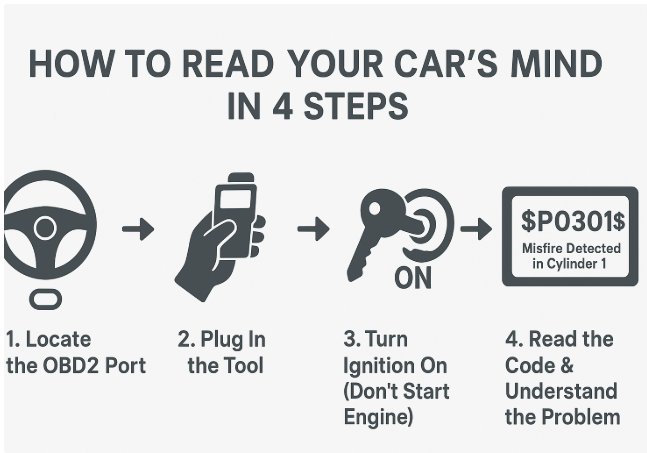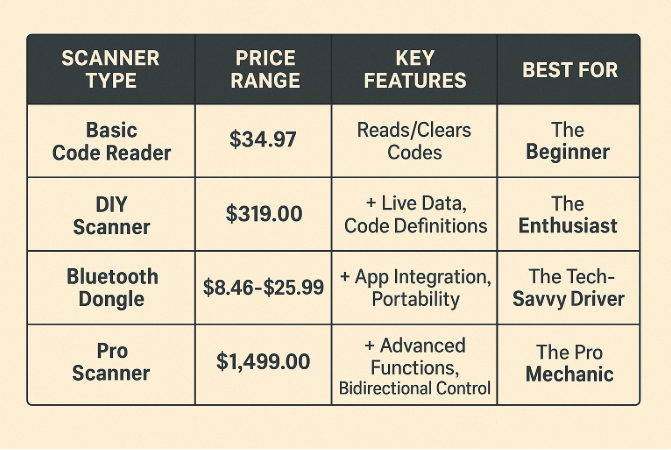What is a Car Diagnostic Tool? Your Ultimate Guide to Saving Time & Money
That sinking feeling. You're driving through town, and suddenly, an unfamiliar light glows on your dashboard. Your mind races: "what does the check engine light mean?" Is it serious? Minor? Either way, you're now thinking about repair bills and lost time.
Thankfully, there's a better way. With the rise of affordable car diagnostic tools, or car code readers, anyone can now perform engine diagnostics at home. These devices, once exclusive to mechanics, plug into your car and act as a vehicle health monitor, quickly helping you understand and resolve issues on your own.
This guide will walk you through how to scan a check engine light, understand diagnostic codes, and use a car diagnostic tool to take charge of your vehicle's maintenance, saving you both time and money.
Key Takeaways
- Instantly Decode the "Check Engine" Light: A car diagnostic tool acts as a translator for your vehicle, converting confusing error codes (like $P0420$) into plain English. This immediately tells you whether you're facing a simple issue, like a loose gas cap, or a more serious problem requiring urgent attention.
- Drastically Cut Repair Costs: The primary benefit is financial savings. By running your own diagnostics, you eliminate expensive mechanical diagnostic fees (often $50-$150 per scan) and are empowered to perform simple DIY fixes, potentially saving hundreds of dollars on parts and labor.
- Gain Empowerment at the Repair Shop: Walking into a mechanic's shop already knowing the specific trouble code gives you control. It allows you to have an informed conversation, prevent unnecessary repairs, and ensure the technician addresses the correct problem from the start.
- Accessible for Everyone, Not Just Mechanics: These tools are designed for the average consumer. They plug into a standard OBD2 port, found on virtually all cars manufactured since 1996, and are incredibly easy to use—simply plug it in, turn the ignition on, and read the results.
- Diagnosis, Not a Magic Fix: A crucial takeaway is that clearing a trouble code only turns off the warning light; it does not fix the underlying issue. The problem must be repaired properly, or the light and the fault will inevitably return.
- No Experience Needed: Most scanners are plug-and-play, making how to scan your check engine light simple—even for first-timers.
- Don't Just Clear Codes—Fix the Problem: Learn the crucial difference between turning off a dashboard light and solving the real issue behind it.
What Exactly is a Car Diagnostic Tool?
A car diagnostic tool, also commonly known as an OBD2 scanner, is an electronic device that plugs into your vehicle's computer system to read and interpret data. Think of it as a translator. Your car's computer (the Engine Control Unit or ECU) speaks in a language of codes; the diagnostic tool translates these codes into plain English, telling you what's wrong.
Every car and light truck manufactured for sale in the United States since 1996 (and in other regions around the same time) is equipped with an On-Board Diagnostics (OBD2) port. This port is the universal gateway for any standard scanner to access your vehicle's health information.
The tool doesn't just read "Check Engine" light codes. It can access a wealth of data about your car's performance, from engine temperature and RPM to oxygen sensor readings and fuel trim.
How Does a Car Diagnostic Tool Work?
Using a car diagnostic tool is surprisingly simple. You don't need any mechanical experience. The process can be boiled down to four easy steps.
- Locate the OBD2 Port: This 16-pin port is almost always located under the driver's side dashboard, usually near the steering column or pedals. A quick online search for your car model and "OBD2 port location" will show you exactly where it is.
- Plug in the Scanner: With the car turned off, simply plug the diagnostic tool's connector into the port.
- Turn the Ignition On: Turn the key to the "On" position, but do not start the engine. This powers up the car's computer and the scanner, allowing them to communicate.
- Read the Codes (via the device's screen or connected app): The scanner will automatically link with the ECU. Follow the on-screen menu to "Read Codes" or "Scan." The device will display any Diagnostic Trouble Codes (DTCs) it finds. A typical code will look something like $P0420$ or $C0035$. Good scanners will not only show you the code but also provide a definition, such as $P0420$ - Catalyst System Efficiency Below Threshold (Bank 1).

An Infographic Showing How to Read Your Car's Mind in 4 Steps
5 Compelling Reasons You Need a Car Diagnostic Tool
If you're still on the fence, here are the key benefits that make a diagnostic tool an essential item for any car owner.
Demystify the Check Engine Light
This is the most common reason people buy a scanner. The light can indicate anything from a loose gas cap (a simple fix) to a serious engine misfire (an urgent problem). A scanner tells you the difference instantly, giving you peace of mind and helping you decide your next move.
Save Significant Money on Repairs
This is the big one. An OBD2 scanner saves you money in several ways:
- Avoid Diagnostic Fees: Mechanics typically charge anywhere from $50 to $150 just to hook up their scanner. Your own scanner pays for itself after just one use.
- DIY Simple Fixes: Many codes point to easy fixes you can do yourself, like replacing an oxygen sensor. Buying the part and doing it yourself can save you hundreds in labor costs.
- Prevent Major Damage: By catching a small issue early (e.g., a minor coolant leak), you can prevent it from turning into a catastrophic engine overheat.
Empower Yourself in the Repair Shop
Even if you don't perform the repair yourself, walking into a mechanic's shop armed with knowledge is a game-changer. You can have an informed conversation, saying "My scanner is showing code $P0442$, indicating a small leak in the EVAP system. Can you perform a smoke test to confirm?" This prevents you from being sold unnecessary services and ensures the mechanic addresses the correct issue.
Monitor Your Vehicle's Health in Real-Time
Many modern scanners do more than just read codes. They can display live data streams from your car's sensors. You can monitor your engine's coolant temperature, RPMs, and fuel pressure as you drive. This is invaluable for diagnosing intermittent problems and getting a deeper understanding of your vehicle's performance.
Simplify Used Car Inspections
Looking to buy a used car? A diagnostic tool is your secret weapon. Plug it in to check for any current trouble codes. More importantly, you can check the "I/M Readiness" status to see if the seller recently cleared codes to hide an existing problem. This simple check can save you from buying a lemon.
Types of Car Diagnostic Tools: Which is Right for You?
Diagnostic tools come in a few main varieties, catering to different needs and budgets.
- Basic Code Readers: These are the most affordable, entry-level devices. They read and clear generic engine trouble codes.
- DIY Scanners: This is the sweet spot for most car owners and enthusiasts. These handheld devices have a screen, offer code definitions, and often include features like live data and freeze frame data.
- Bluetooth/Wi-Fi Dongles: These small adapters plug into the OBD2 port and connect wirelessly to an app on your smartphone. They are incredibly convenient and powerful, offering a user-friendly interface.
- Professional-Grade Scanners: These are high-end tools used by mechanics. They offer advanced functions like programming keys and testing individual components (bidirectional control).

An Infographic Showing a Comparison Chart of Which OBD2 Scanner is Right for You
The Verdict: A Smart Investment for Every Driver
A car diagnostic tool is more than just a gadget; it's an investment in control. It bridges the communication gap between you and your vehicle, transforming confusing warning lights into actionable information.
For a small upfront cost, often less than the price of a single diagnostic fee at a dealership, you equip yourself with the power to make informed decisions, tackle simple repairs, and save a fortune over the life of your car. Don't wait for the next mystery light to appear on your dash. Take control of your car's health today.
Frequently Asked Questions (FAQ)
Can a diagnostic tool damage my car's computer?
A: No. When used correctly, a standard OBD2 scanner is a read-only device. It simply requests and receives data from the ECU without altering any programming. It is a safe and standardized procedure.
Will clearing a trouble code fix the problem?
A: No, and this is a critical point. Clearing the code only turns the warning light off. It's like silencing a smoke alarm without putting out the fire. If the underlying mechanical or electrical problem is not fixed, the code and the light will return.
What is the difference between OBD1 and OBD2?
A: OBD1 refers to the pre-1996 systems, which were not standardized. Each manufacturer had its own unique port and codes. OBD2 is the universal system required on all 1996 and newer vehicles, which uses a standard port and a universal set of codes.
Do I need to be a mechanic to use a car diagnostic tool?
A: Absolutely not! Basic code readers and DIY scanners are designed for the average consumer. With the code and its definition, a simple online search can provide you with repair tutorials and advice for common issues.
Relevant Articles:
1. Top 5 Diagnostic Tools Every Mechanic Should Own
2. Ancel AD310 OBD II Scanner Review: A Must-Have for Car Enthusiasts?
3. The 5 Must-Have Diagnostic Scanners for Professional Mechanics in 2025
4. Top 10 Tools Every Professional in the Automotive Industry Should Have
5. The Ultimate Guide to Buying a Car Diagnostic Tool (OBD2 Scanner): Save Time, Money & Avoid Costly Repairs
Conclusion
Investing in a car diagnostic tool is no longer a luxury but a smart necessity for every vehicle owner. Whether you’re a DIY enthusiast or simply want to avoid unnecessary mechanic visits, an OBD2 scanner for cars helps you identify issues quickly, save money on repairs, and maintain your vehicle’s long-term health. By using a professional automotive scan tool or even a Bluetooth car diagnostic scanner, you gain the confidence to understand error codes, monitor performance, and prevent minor issues from becoming costly breakdowns.
In today’s fast-paced world, having the right car diagnostic scanner to save time and money ensures peace of mind, safer driving, and smarter vehicle maintenance.
Call to Action
Ready to take control of your car maintenance?
Don’t wait until a minor issue turns into an expensive repair, take control of your vehicle’s health today! Explore our wide range of car diagnostic tools and OBD2 scanners at Tendsupplies.com and find the perfect tool to save time and money on every repair.
Have questions or need expert guidance? Our team is here to help, contact us anytime at sales@tendsupplies.com.
Start diagnosing smarter, drive with confidence, and keep your car in peak condition with Tend Supplies!






